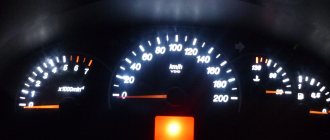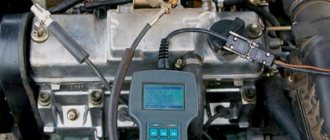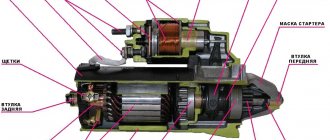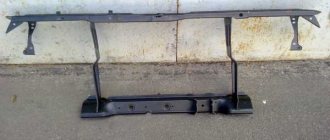The car runs on gas
In the life of every motorist there is a situation when the engine misfires, often this means a banal problem with the spark plug or a couple of other well-known breakdowns. But when it comes to the LPG system, sometimes it can be quite problematic to understand why the engine stalls on gas, but works fine on gasoline, and in this case one cannot do without an integrated approach and analysis of the situation. The car runs on gas for various reasons, but often, even a knowledgeable person is afraid to get into the gas installation and understand the problem, entrusting the troubleshooting to specialists.
In most cases, such caution when working with a gas system is justified, because gas is a flammable substance, and any leakage can result in serious problems. But if there is no opportunity to contact specialists, and the car stalls and stalls when running on gas, you can try to figure out the problem yourself.
Finding out the reasons
Let's try to highlight several reasons why your iron friend struggles on gas.
To determine the cause, it is best to use a computer (laptop), connecting it through a special diagnostic cable to the electronic control unit of the gas system, if we are talking about the fourth generation of gas equipment and higher. If your car has a 2nd generation HBO or there is no way to connect a laptop, you will have to look for the reason the old fashioned way, eliminating step by step the weak points of the system.
HBO filters
First of all, you should check the gas filters; this advice is especially relevant if you have not done annual maintenance on your gas installation, and the car has been running on gas recently. We described in detail how to replace the LPG filter, drain the condensate and perform a complete maintenance of the system in this article.
Candles
The second weak point is the spark plugs. It is necessary to check the gap on the spark plugs, it should be the same on all spark plugs and be within the range of 0.7 -0.9. If scale is visible on a spark plug, this is a clear sign that it is “broken,” and the LPG system is not working on gas. It is also worth noting that there are special spark plugs on sale that are designed specifically for engines that run on gas, it would be wise to purchase them.
Gearbox
One of the most common problems with an engine running on gas is contamination or incorrect adjustment of the system's gas reducer. But in this case, the problem of a gas-powered car will include floating idle speeds, and jerks or loss of power when the engine is running on a gas installation. To begin with, try limiting yourself to cleaning the gearbox and replacing the filter in it (if there is one, of course). If this does not help, you should take a closer look at the repair. kit that will fit your gearbox, and replace the used rubber gaskets in it.
Injectors
A fairly common problem that a car runs on gas but not on gasoline is gas injectors. There can be many reasons for the malfunction of injectors, ranging from their contamination and sticking to simple wear and tear of the design of one of them.
- To determine that the injectors are to blame for unstable engine operation on gas, the easiest way is to place them on a special diagnostic stand.
- The second option is to temporarily replace the injectors with a set that is known to work.
Sticky and dirty injectors can be washed, but worn ones will have to be replaced. To be fair, it is worth noting that quite often technicians at service stations, in case of wear of the injectors, suggest using a repair belt. kit, not new injectors. However, given that the price of rem. kit fluctuates within 50% of the price of new injectors, and considering the cost of work to replace worn-out elements, agreeing to such an offer or buying new parts is not an easy choice.
You should also remember the fact that serviced injectors should be serviced at least once every 30,000 km. Maintenance consists of replacing damper rings and other worn elements.
Remember that after replacing the injectors, a specialist must calibrate them and configure the system while the car is moving.
Wires
The last of the most common reasons is wear of high-voltage wires, but in this case the machine will not only run on gas, but also when running on gasoline.
Air leak
Leaky or loose gas system connections can cause air leaks, which in turn will lead to loss of power and unstable engine operation.
In conclusion, I would like to note that we have identified only the most common reasons that a car stalls on gas, in reality there are many more reasons, and if you were unable to identify the fault yourself, you should contact a qualified technician who will carry out diagnostics and accurately determine and will fix the problem.
Possible reasons
First of all, you need to make sure that the engine runs on gas and not on gasoline. A gasoline engine can be unstable for many reasons. A serious check of the ignition and power systems is required. There are also breakdowns of the engine itself, when compression in one of the cylinders decreases and the fuel does not burn completely.
When a car runs normally on gasoline, damage to the gasoline fuel system can be ruled out. Carburetors can also be taken into account if the car drives well when switching to gasoline. Only problems with HBO are considered.
Many people are familiar with the operating principle of gas equipment, but it is not always possible to understand everything constructively. Therefore, it is not always possible to independently determine the causes of unstable operation of the internal combustion engine, and even more so to eliminate breakdowns.
In addition, operating a machine with gas equipment using methane or propane-butane is not always safe. Gas leaks can lead to fires or cylinder explosions. Therefore, if there is a fear that further operation of the equipment is not safe, then it is better to refuse independent repairs. In this case, you need to entrust the determination of the machine breakdown to qualified specialists.
So, if the problem is in the gas equipment, there is no danger of a gas leak, it means that some element has failed or the settings have gone wrong.
When a 4th generation LPG engine is running, the best diagnostic option is to connect to a test bench. Using a computer, it will immediately become clear what to change and configure. When a VAZ 2107 is in the 2nd or 3rd generation, it is not possible to visit a car service center; you can figure out the reasons by checking every detail step by step.
Filters
The simplest and most cost-effective thing that can happen if the gas equipment is running cold or hot is clogged gas filters. Pulling out the filter element and replacing it if it is very dirty is not difficult.
If the car's mileage is more than 10 thousand km, the filters need to be replaced in any case.
When everything is normal with the filter system, the car owner is sure that they have been changed recently, you can proceed to the next stage of testing.
Candles
Faulty spark plugs are likely causes of problems. The gaps in them are checked. They should be 0.7 -0.9 and be the same on all candles. Scale on any spark plug indicates that the part is unusable. This is the answer to the question why the car stalls on gas. When a spark plug is broken, the engine loses power and often stalls at the start. Replacing the spark plugs in this case will solve the problem.
Today it is possible to purchase spark plugs designed for operating gas-powered internal combustion engines.
Gearbox
When a car starts running on gas but not on gasoline, the most common cause is a dirty or poorly configured gas reducer.
As a rule, floating idle speed is also added to the problem that the car stalls on gas. When the car switches from gasoline to gas fuel, the engine runs unstable and jerky. If you accelerate, trying to increase speed, you feel like power is lost.
The first thing you can do is clean the gearbox and replace the filters in it (if any). The next step is to change all worn-out gaskets using a repair kit.
Read more: Nissan Pathfinder technical specifications
In the worst case scenario, a new evaporator reducer will need to be installed.
Injectors
Dirty and faulty gas injectors are the cause of interruptions in the operation of the power plant; the engine runs rough on gas.
If the injectors are not functioning properly, the air-gas mixture does not enter the cylinders stably. When the engine runs on gas, there is a significant consumption of gas fuel and reduced power. Sometimes this leads to the process of explosive ignition of the gas-air mixture in the cylinders.
Injectors sometimes do not close tightly or open with a significant delay. All this negatively affects the power plant, and it may happen that after installing the HBO, for example, cylinder 3 is damaged. The injectors need to be checked on a stand, washed, troubleshooted, and calibrated.
It is not uncommon for injectors to need to be replaced. This means that initially low-quality components were supplied to the car.
Dirty injectors can be washed, but worn ones must be replaced. In the second case, craftsmen may suggest using a repair kit. Its price is about half cheaper than the new injectors that are included in the 4th generation LPG kit. But you need to add the cost of replacing the elements, and only then choose what is cheaper.
Injectors that are subject to maintenance and repair are inspected every 30 thousand kilometers. Usually damper rings and other worn elements are replaced.
Electrical wires
Problems with the electrical wiring can cause the engine to start stalling if the engine is switched to gas.
This reason is less common, but not excluded. Most often this concerns modern gas-cylinder systems with complex electronics.
Failures in electronic control units lead to incorrect mixture formation and failures in the supply of gas fuel occur.
The reason for unstable operation when switching to gas may be a violation of the insulation inside the emulator, when the signal goes to one resistor. After isolating the damaged area, the problem will go away.
Air entry
Depressurized gas line connections sometimes cause air leaks. This inevitably leads to loss of power and engine tripping.
Interruptions in the operation of the system occur due to a torn pipeline going from the gas train to the collector. While the motor is running, knocking noises are heard. After replacing the tube, the issue goes away.
The engine runs rough on gas: why does this happen?
As you know, installing gas equipment is practically the only way to reduce fuel costs in the case of gasoline cars. The main advantage is the more affordable price of gas compared to gasoline or diesel fuel.
The result is unstable engine operation; the driver notes that the engine is running rough on gas, although the unit can operate normally on gasoline. Also, quite often, along with tripping, gas consumption increases, throttle response and traction disappear. In some cases, a “check” may light up on the dashboard. Next, we will look at common reasons why a gas engine stalls.
The engine runs fine on gas, but runs fine on gasoline - reasons
The easiest and most correct way to look for the reason why the engine is shaking on gas is to connect a diagnostic scanner. With its help, you can find out exactly the cause of the malfunction based on the error recorded in the ECU. However, if there is no scanner or you do not have the opportunity to visit the gas workers, you can try to find the cause of the breakdown at random.
1. Check gas filters. If you have replaced gas filters a long time ago, it would be a good idea to check their condition and replace them if necessary.
2. If replacing gas filters does not lead to anything, we continue our search. Check the condition of the spark plugs; often the engine stalls and stalls on gas precisely because of problems with the spark plugs.
3. BB wires. High-voltage wires can cause tripping, but in this case, most likely, the engine will run unevenly on gasoline.
4. Gas reducer. If the gas reducer is configured incorrectly or is very dirty, it is quite possible that this kind of trouble will occur (idle speed floats, jerks while running on gas, engine roughness ). Clean the gas reducer, replace filters and, if necessary, replace worn rubber gaskets, this will require a repair belt. kit for the corresponding gearbox. In some cases, it may be necessary to completely replace the gas reducer.
5. Gas injectors. A problem with injectors can often manifest itself in the form of tripping. Due to malfunctions of the injectors, ignition of the gas mixture occurs intermittently, as a result, gas consumption increases, the engine suffers, and detonation is also possible. A common problem with injectors is the so-called “non-holding”. You can check this on a diagnostic stand or at home, having some experience. This situation can be corrected by washing the gas injectors, troubleshooting and subsequent calibration.
The engine stalls when switching from gasoline to gas: what should the driver do?
Let's start with the fact that a gasoline engine misfires for a number of reasons. In other words, in-depth diagnostics of the ignition system, power supply, ECM, etc. are required. Also, the cause of tripping can be a breakdown of the internal combustion engine itself, when compression in any cylinder is reduced and the fuel in this case does not burn.
If we talk about HBO, when the engine runs on gas, but the operation on gasoline is not satisfactory, in this case we can rule out problems with the gasoline power system and compression. In this case, possible problems with gas equipment are automatically added to the general list. Let's figure it out.
As a rule, the operating diagram of gas equipment is known to many, but the design is not studied by all car enthusiasts. It is for this reason that not everyone is able to independently determine the cause and eliminate the breakdown.
The situation is often complicated by the fact that drivers try to avoid working with gas equipment, fearing an explosion or fire due to gas leaks. Let us note right away that if you are not confident in your abilities, then such fears are partially justified and it is better to abandon attempts at self-repair. It is optimal to deliver the car to a service center so that the car is handled by qualified specialists.
Let's return to the problem. In the case when it is necessary to determine the cause yourself, then it should be noted that in practice it is not always necessary to disassemble the gas equipment, remove individual elements of the system, etc., in order to understand exactly why the engine is running on gas, although it works fine on gasoline.
In this case, the scanner may not be at hand, and it is also not possible to visit a service station. In this situation, it is necessary to use the elimination method, checking the important and critical elements of the gas equipment in order.
- First of all, you need to start by checking the gas filters. These elements need periodic replacement, as they tend to clog during operation. To check, it is enough to remove the filter and inspect it for severe contamination, which may cause a decrease in the throughput of the filter element.
If the driver is sure that the filters have been changed a long time ago, then you can safely go for new ones, since in most cases the problem of engine tripping will be solved by a complete replacement of gas filters.
- If the filters are clean/new or the problem is not resolved after replacing the filters, you need to proceed to checking the ignition system. As a rule, diagnosis begins with an inspection of the spark plugs. Their integrity, the condition of the electrodes and the housing are checked. You can then test for spark.
Please also note that the spark plugs may be in perfect order, but the engine stalls or stalls on gas and gasoline as a result of breakdowns or damage to the high-voltage armored wires of the spark plugs. Quite often this manifests itself in the form of tripping at idle, especially in wet weather. Wires need to be checked and replaced if necessary.
- The next element that may be the culprit is the gas reducer. The specified gearbox may be incorrectly configured, and the possibility of its severe contamination should not be ruled out.
GAZelle with Chrysler engine. The engine occasionally stalls and does not develop power.
Report No. 100 A client came in for diagnostics (a GAZelle car with a Chrysler engine). Problem: the engine occasionally stalls and does not develop power. As is customary, they asked the owner of the car what had been done before. According to the client, it turned out that the control unit had previously been reprogrammed “flashed” to the E2 toxicity standard without misfires (this function does not detect misfires and does not enter a fault code into the memory of the control unit). This is often done at the request of the client, so as not to repair the internal combustion engine, of course, within reason (when the engine is still functional). If the wear is critical, no ECU firmware will help)))). We connected the Autoas-scan scanner, there were no errors, including misfires, although the engine was malfunctioning. It is clear that the control unit has been reprogrammed - “flashed”. We also learned from the client’s words that the service center measured the compression in the cylinders; it was 12-13 bar. As for the compression meter, I will say this; we use it very rarely in diagnosing modern engines. Since this device is very rough in its measurements and if the valve is slightly burnt out, it will not show this, the compression will be normal. So we decided to double check. The fact is that it is difficult to check the mechanics on this engine. This is due to the fact that cylinders 2 and 3 are located under the throttle assembly. Any manipulation with these cylinders requires partial disassembly of the throttle assembly (pictured below). We decided to use USB Autoscope (Postolovsky’s oscilloscope), and in particular Andrey Shulgin’s CSS script. The “CSS” script can serve as a good help in finding the causes of chaotically occurring misfires, as well as in diagnosing an unevenly running engine. But it should be noted that in cases where the cylinder(s) are completely inoperable, the CSS script does not allow identifying the area of origin of the malfunction - the ignition system, or the fuel supply system. Thanks to the script, we saw that the 3rd cylinder lags behind during transient conditions. We decided to screw the pressure sensor into the 3rd cylinder. But how to do this because the throttle assembly is located just above the 3rd cylinder. Yes, removing the throttle assembly is not a problem, the problem is that the pressure sensor checks the cylinder at idle. Standard extensions and adapters have the form of an aluminum tube with a rigid connection. An adapter from the MTpro4 oscilloscope came to the rescue; it is made of a heat-resistant rubber hose (pictured below) that can withstand high pressure. To measure the pressure in the cylinder, an Avtoas-Express single-channel oscilloscope was used. You probably already guessed why Autoas-Express, because it has a minimum of settings, has auto-sync and is easy to use. The oscillogram (pictured) shows that there is a mechanical fault in the 3rd cylinder. We will inform you about the malfunction later after opening the cylinder head.
We invite you to study other articles about repairs in our laboratory:
You can sign up for the Diagnostic course here:
Let's sum it up
Listed above are the most common reasons why the engine stalls on gas. At the same time, there are also a number of other failures and breakdowns that lead to uneven operation of the engine at idle, under load, “cold” or “hot”. Often, without the proper experience and professional equipment, it is quite difficult to eliminate a non-obvious cause with your own hands.
It is also important to trust the installation only to experienced gas workers and qualified specialists, since incorrect installation and configuration of gas equipment can lead not only to incorrect operation and rapid failure of gas equipment, but also to serious consequences for the engine (including major repairs).
Even during operation, it is important to remember that LPG requires scheduled maintenance, like any other system in a car. It is necessary to promptly change gas filters, clean the gearbox, etc. In parallel, after switching to gas, you need to correctly select a separate oil for gas engines for your car, regularly change spark plugs, etc.
In idle mode and at low speeds, the engine shakes: possible reasons for the unstable operation of the power unit. Self-diagnosis methods.
Why might the engine vibrate at idle? Causes of malfunction, diagnostics. Tips and recommendations for reducing engine vibration levels.
At idle the speed “floats”: why does this happen? The main malfunctions associated with idle speed on gasoline and diesel engines.
Why the engine may have high idle speed. The main reasons for high idle speed on an injection engine and engines with a carburetor.
Floating engine idle speed when cold. Basic malfunctions, symptoms and identification of breakdowns. Unstable idling of the diesel engine.
Signs of a non-working cylinder (tribbing and vibration) of a diesel engine. Troubleshooting: compression, diesel injectors, glow plugs, injection pump and others.
see also
Comments 40
good day, when accelerating it also troits, if you accelerate well, the silencer shoots, everything seems to run fine on gasoline. The idle is smooth on both gas and petrol. I also have to figure it out(((
The solution was to replace the ignition coil. As a wire option (check), reducing the gap on the spark plugs gave a temporary effect.
I have exactly the same problem, changed the spark plugs, drove 300 km, same problem, someone says there are rubber seals in the gas injectors, you have a coil
everything was resolved by replacing the ignition coil, everything else gave a temporary effect!
It is possible that after a mileage of 150 to 300 km, the membrane in the gearbox sags. I had this happen, I drove up, adjusted the pressure in the gearbox and that’s it.
But the wires were not mixed up, they were just powered differently.
The hose was probably just pinched
So gentlemen. The trouble seems to have been resolved. I went to the installers today. I pointed out these problems, I don’t know how to say it correctly, in general they repowered it differently, the tripping went away, it doesn’t twitch at idle, the checkbox doesn’t light up. Thanks to all.
Idk. If I go to zero, I’ll push them around. Can anyone suggest an intelligent diagnostician in Kyiv?
I also had the wires from the injectors mixed up! And you need to change the spark plugs!
The spark plugs were changed... the wires too... It became better but by 50%. The check is on. The tuners say that the mixture may be lean. The consumption is the same as on gasoline. Traction too. I would like to remove the error and tripping.
check if the hose that goes from the rack to the manifold is pinched
When installing the HBO4 digitronic, the wires to the injectors were mixed up and I had similar problems... by the way, this problem was found out not by my installer, but by a third party, who joined the brains of the HBO... for me it was expressed this way - when starting smoothly from a traffic light, the engine worked intermittently (like as if it was missing something), with the air conditioner on and in the parking lot, the engine could stall... it went along the highway normally for a while, then twitching began...
I had similar symptoms. At first it worked fine on gas, but troubled on gasoline. Then it started to triple on gas, and doubled on gasoline. Then the gas stopped working altogether... In general, a glass of greenish liquid was poured out of the brain case, the entire board was covered with an oxide the consistency of sea-green yogurt











